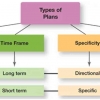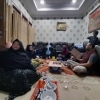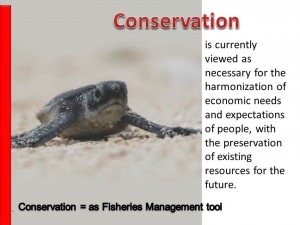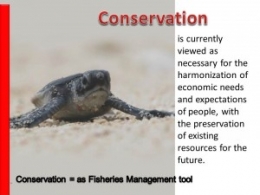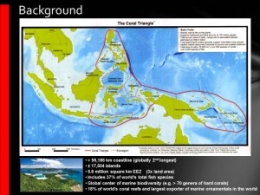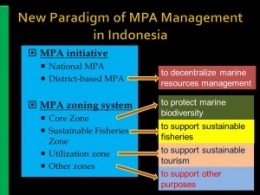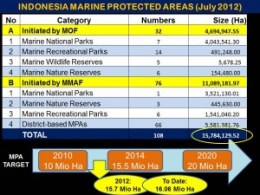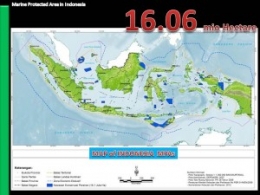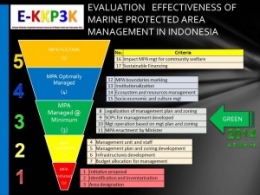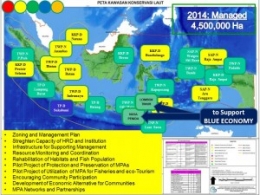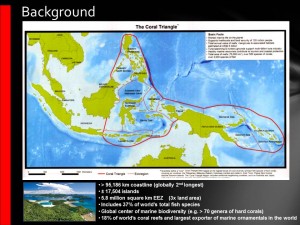
Unfortunately, environmentally destructive fishing practices, improper waste disposal, sand mining, and other damaging human activities have threatened the sustainability of ecosystem resources, specifically coastal and small island ecosystems. In addition to this, sub-system fishing pattern levels, non-fishermen oriented fishing result, value chain system, and low educational background have lead to unsatisfactory living standards of coastal people. The number of Indonesia’s poor fishermen reached 7.87 million people (2011), from approximately 10,600 fisherman villages across many coastal areas in Indonesia. This represents 25.14 percent of Indonesia’s total number of poor people, which reached 31.02 million people across the archipelago. We realize that the management of coastal and small island resources must comply with protection and preservation efforts, to ensure that fisheries resources are maintained for the prosperity of the current generation as well as for those of the future. Law No. 27 of 2007, and Regulation of the Minister of Marine Affairs and Fisheries No. Per.17/MEN/2008, mandate and regulate how conservation should best operate in these areas to achieve this objective. In his speech at the 2009 World Ocean Conference (WOC) in Manado, President Susilo Bambang Yudhoyono declared Indonesia’s commitment to reach 20 million ha of MPAs/KKP3Ks by 2020. The Ministry of Marine Affairs and Fisheries continues to strive to realize this target in order to maintain the sustainability of marine potential in Indonesia.
Conservation issues have become a global concern and strategic issues in many countries, including Indonesia. Abundant in resource potential, Indonesia is required to be able to manage its marine and fisheries resources effectively and sustainably for the prosperity of its people. Fisheries resource conservation may be defined as an effort to protect, preserve, and utilize fisheries resources, including the ecosystem, species and genes to assure their existence, supply and sustainability by preserving and increasing the quality of the value and variety of fish resources. We realize that the management of coastal and small island resources must comply with protection and preservation efforts, to ensure that fisheries resources are maintained for the prosperity of the current generation as well as for those of the future. Law No. 27 of 2007, and Regulation of the Minister of Marine Affairs and Fisheries No. Per.17/MEN/2008, mandate and regulate how conservation should best operate in these areas to achieve this objective. In his speech at the 2009 World Ocean Conference (WOC) in Manado, President Susilo Bambang Yudhoyono declared Indonesia’s commitment to reach 20 million ha of MPAs/KKP3Ks by 2020. The Ministry of Marine Affairs and Fisheries continues to strive to realize this target in order to maintain the sustainability of marine potential in Indonesia. It should be admitted that the application of the old paradigm–which framed the management of protected areas as centralistic and closed/prohibited to all parties in the context of its use–lead to less socio-economic advantages of MPAs/KKP3Ks for local populations. Today, that paradigm has changed, and conservation efforts and resource use are better combined in a mutually beneficial and responsible framework. The Ministry of Marine Affairs and Fisheries, through the Directorate for Conservation of Area and Fish Species, looks to answer the challenges arising from this conservation paradigm change. Based on Directorate General strategy, our Directorate has developed strategic planning for the period of 2009 and 2014, which was translated into annual target for conservation of areas and fish species. For conservation of areas, we have targetted to add 2 (two) million hectare during 5 years, and to manage 15 endangered species. We also have targetted to manage effectively 4.5 million hectare of MPA.
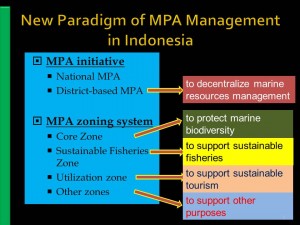
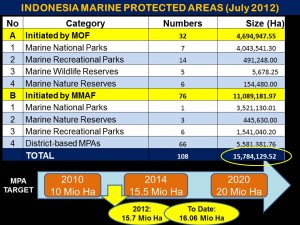
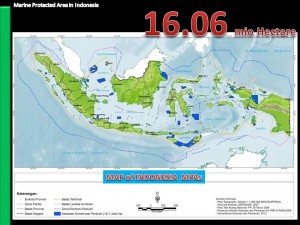

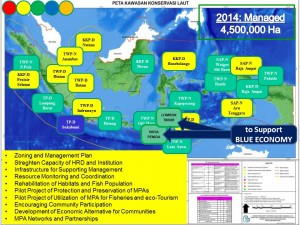
This year (2013) we have started to develop E-MPA Awards. This awards aims to encourage the MPA managers to better improve their MPAs management. The conservation area deemed to have the most effective management will be rewarded with an “Anugerah E-KKP3K” (E-MPA Awards). Now, we are on going progress to evaluate each MPA and the celebration will be end of this year at the Nusantara day event. This agenda should motivate the managers of these conservation areas to continue to work hard to create conservation areas that are effectively and sustainably managed. As well as the “Anugerah E-KKP3K” (E-MPA Awards), or another key output of these activities is the recommended management priorities for the all conservation areas that have been evaluated. In the regional context, such as in the coral triangle initiative (CTI), E-MPA has been shared and presented, particularly as part of the agenda of CT MPA Regional Exchange during the development of Coral Triangle Marine Protected Areas System (CTMPAS), as well as in the regional cooperation on marine conservation and sustainable fisheries management of Sulu Sulawesi Marine Ecoregion (SSME) involving 3 countries of Indonesia, Malaysia, and Philippine. During CTI Regional priority workshop held in Manado recently, Indonesia has proposed to be the host of MPA Regional recognition (Awards) for CTMPAS in 2014.
As we mentioned before, our government commitment to set up 20 million ha of MPAs in 2020, we have conducted the study with some expert for a priority geography for marine biodiversity conservation in Indonesia. The book was published in 2012, particularly based on three ecological criteria of: 1) Irreplaceability = degree of endemism, taxonomic uniqueness, presence of rare species/habitats,etc.); 2) Vulnerability = different methodologies prioritize either low risk regions or highly threatened regions; and 3) Representativeness= particularly when a planning unit such as a country’s national boundaries cross biogeographic realms. First priority is Papua ecoregion, second Banda Sea, third Lesser Sunda, fourth makassar strait and sulawesi sea, and so on, the last is mallaca strait (rank 12). Beside the size of MPAs, Scientifically we need to protect about 30% of critical habitats. With this regards, up to 2010 (based on our gap analysis study) we have protected about 22.7 % of coral reefs, 22% of mangrove and just 17.3% of seagrass. Since we need to protect about 30% of critical habitats and to included in the MPAs, so we need more about 240 thousand of Coral reefs, 277 thousands of mangroves and 222 thousands of seagrass. (the total area for each ecosystem is counting from the total area of potential data critical habitats (mangrove, coral reefs and seagrass). To expand of marine protected areas, we have one reference from the marine experts study about Gap analysis. So in the future, based on this study, the marine experts recommended us to develop additional MPAs in first priority on halmahera ecoregion, and then in the ecoregion of sulawesi seas dan west sumatera ecoregion, and the next is adding the new MPA in Lesser sunda, banda sea, arafura sea and papua. The last is in the rest of 5 (five) others ecoregion area.
Our homework is remains huge to develop and manage our MPA effectively inline with global target to manage at least 10% (ten percent) of our coastal and territorial marine area. In short, we will continuing to expand and achieving target 20 million hectares of new MPAs in 2020; strengthen management of MPAs (4,5 Million Hectare of MPA Effectively Managed, including Conservation management for 15 Charismatic Species, endangered and endemic aquatic species); we have been preparing a new strategic plan for 2015-2019); Ensure benefits of MPAs especially on fisheries and eco-tourism; Implementing collaborative management that promotes partnership among governments, communities, and the private sector in MPA management; improving the Community Empowerment; developing MPA Networks; developing Sustainable financing schemes to support management of MPAs; Encourage industries to allocate their CSR (Corporate Social Responsibility) budget to support MPA management programs; strenghten and updating Information system on MPA management; and the last but not least is the implementation of Coral reefs rehabilitation and management – Coral triangle initiative (COREMAP-CTI) which continuing from the successful COREMAP II program. Several challenges we have been facing, such as: the changes of commitment of local government; spatial planing that should be include MPA in integrated coastal zone management; lack of human resource capacity to manage of MPAs; lack of knowledge and skill for MPA manager and practitioner; and last but not least is lack of funding in MPA Managements;


